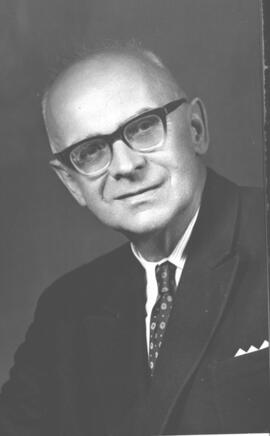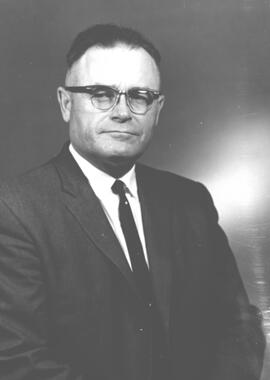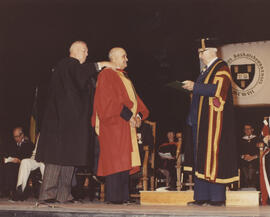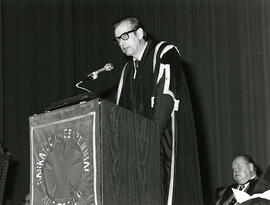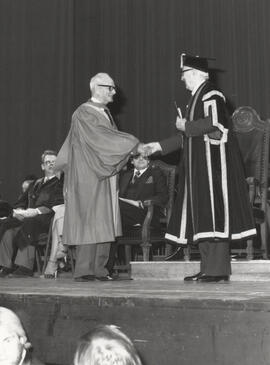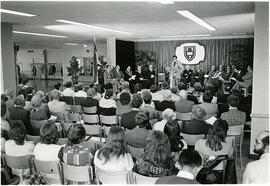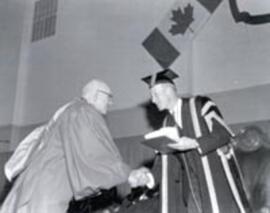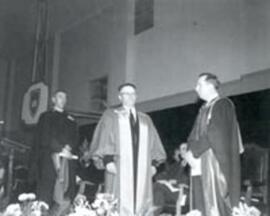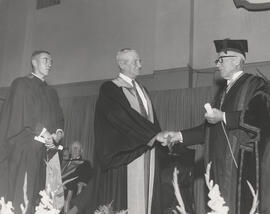Dr. Leo F. Kristjanson being installed and robed by Norman K. Cram, University Registrar, after Christine Pastershank, Board of Governors, presented him to Emmett M. Hall, University Chancellor, who administered the oath of office. During Convocation ceremony held at Centennial Auditorium.
Bio/Historical Note: Dr. Leo Friman Kristjanson was born on 28 February 1932 at Gimli, Manitoba. He attended the University of Winnipeg, earning a BA and an MA in history. In 1957 he began studies in Agricultural Economics at the University of Wisconsin. Upon finishing his course work in 1959, he accepted a position with the Centre for Community Studies at the University of Saskatchewan. The Centre was established to undertake a program of applied social research related to the development of Saskatchewan communities. In 1960 he began lecturing in the Department of Economics and Political Science, and completed his PhD in 1963. In 1965 Dr. Kristjanson joined the Department of Economics and Political Science. He was vice-president (Planning) of the University from 1975 to 1980, and in 1980 he became president of the U of S. Illness prevented him from completing his second term, and he retired in 1989. The atrium in the Agriculture building at the U of S is named in honour of Dr. Kristjanson’s contribution to the University. As president he sought funding for agricultural research and a new College of Agriculture building. He formed a “Sodbuster’s Club” to raise planning funds and undertook a leadership role in raising over $12 million from private sources for the construction of the building. Dr. Kristjanson was also instrumental in improving the Soil Testing Laboratory, the Poultry Centre, the Kernan Crop Research Laboratory, the Horticulture Field Service Building, the Saskatchewan Institute of Pedology’s Field Facilities, and the Large Animal Research Facility. Dr. Kristjanson was also instrumental in having an art gallery become part of the new College of Agriculture building, named in honour of the first resident artist at the university, August (Gus) Kenderine. Also during his term as president, the Centre for the Study of Co-Operatives, Toxicology Research Centre and the Centre for Agricultural Medicine were established. Dr. Kristjanson made major contributions to rural Saskatchewan as a consultant to farm organizations, co-operatives, credit unions, and governments. He served on boards and participated in projects designed to improve living conditions for farmers and their communities. Dr. Kristjanson was chairman of the Saskatchewan Natural Products Marketing Council from 1973 to 1979; a member of a committee to recommend restructuring of the Department of Co-operation; and chairman of the Board of Public Inquiry into the Poplar River Power Project, a provincial study of the environment. Dr. Kristjanson also wrote extensively and has given many public speeches on co-operatives, population and rural development, marketing boards, and commissions. He retired as president in 1989 due to health reasons, a year before the end of his second term. In 1990, Dr. Kristjanson was made a Member of the Order of Canada. He was inducted into the Saskatchewan Agricultural Hall of Fame the same year. After retirement, Dr. Kristjanson moved back to his hometown of Gimli, where he died on 21 August 2005.



